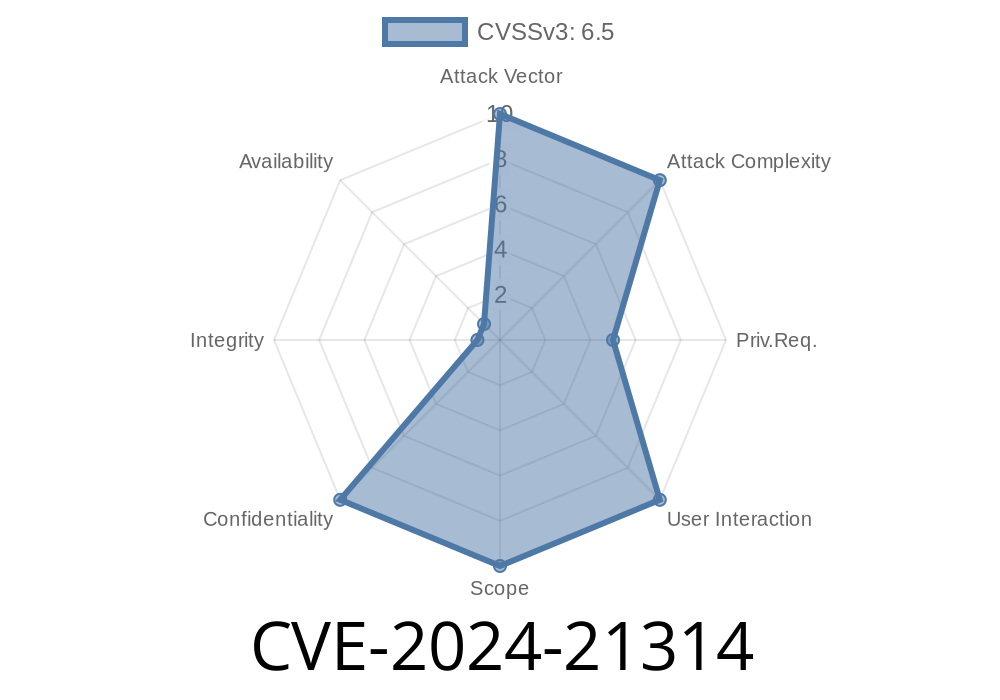In this article, we will discuss the important details of CVE-2024-21314, a critical vulnerability that affects the Microsoft Message Queuing (MSMQ) service. This vulnerability allows malicious attackers to gain unauthorized access to potentially sensitive information and, if left unpatched, can expose your system to various security risks. We will delve into the exploit details, provide code snippets for better understanding, and offer recommended mitigation steps. Links to original references are provided so you can further explore and learn about this profound security flaw.
Exploit Details
Microsoft Message Queuing (MSMQ) is a Windows-based message queuing and communication service that allows multiple applications to communicate across heterogeneous networks and systems. This service is susceptible to an information disclosure vulnerability, as designated by CVE-2024-21314. Attackers can exploit this vulnerability by sending specially crafted packets to the affected MSMQ service, thereby allowing them to obtain information that they are not supposed to access.
This information disclosure vulnerability specifically impacts the Microsoft Message Queuing HTTP Transport component. An attacker exploiting this vulnerability can access sensitive information like internal network topology and infrastructure layout by sending a specially crafted packet to the victim's machine.
Proof of Concept (PoC)
Here's a simplistic code snippet that demonstrates how a potential attacker could exploit the vulnerability:
import requests
# Replace with the target machine's IP address and port number
target_url = "http://<target IP>:<port>/queue/messages"
# Send a specially-crafted packet to the target MSMQ service
response = requests.get(target_url)
# If successful, display the acquired information
if response.status_code == 200:
print(response.text)
else:
print("Failed to exploit the vulnerability")
It is worth noting that this code snippet only provides a basic concept of how the vulnerability could be exploited. In a real-world attack scenario, a malicious actor would likely use more sophisticated methods for crafting the packet and parsing the information obtained from the target MSMQ service.
To gain more in-depth knowledge about this vulnerability, you can refer to the following resources
1. Microsoft Security Advisory: Microsoft's official security bulletin related to CVE-2024-21314, which provides a detailed explanation of the vulnerability, affected systems, and possible mitigation steps.
2. Common Vulnerabilities and Exposures (CVE) Details: The official CVE database entry for this vulnerability, containing information on the description, impact, and references for CVE-2024-21314.
3. National Vulnerability Database (NVD) Details: NIST's National Vulnerability Database (NVD) entry for CVE-2024-21314, offering an in-depth analysis of the vulnerability, including impact metrics and potential countermeasures.
Mitigation
To mitigate the impact of CVE-2024-21314, Microsoft has released updates that address the vulnerability. It is strongly recommended that you apply the available updates as soon as possible to protect your systems from potential exploitation. Follow the steps below to update your systems:
1. Review the Microsoft Security Advisory (link) related to CVE-2024-21314.
2. Download the appropriate updates for your system from the Microsoft Download Center or Windows Update.
Install the updates following Microsoft's guidelines and reboot your system if prompted.
In addition to applying the updates, you should also practice good security hygiene, such as limiting access to critical systems, implementing proper network segmentation, and regularly monitoring your system logs for any signs of suspicious activity.
Conclusion
CVE-2024-21314 is a noteworthy vulnerability that has the potential to cause detrimental effects on your systems if left unaddressed. By understanding its exploitation details, reviewing the code snippets provided, and referencing the original sources, you will be better equipped to safeguard your systems against this security flaw. Remember to apply the available patches in a timely manner and maintain good security practices to minimize the risks associated with this vulnerability.
Timeline
Published on: 01/09/2024 18:15:55 UTC
Last modified on: 04/11/2024 20:15:18 UTC
